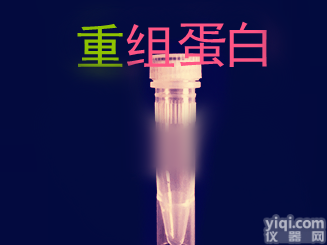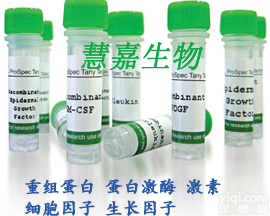| 英文全称: Recombinant Human CLIC1/Chloride intracellular channel protein 1 |
| 缩写:CLIC1/Chloride intracellular channel protein 1 |
| 种属:Human |
| 储存条件:Lyophilized protein should be stored at < -20°C, though stable at room temperature for 3 weeks.Reconstituted protein solution can be stored at 4-7°C for 2-7 days.Aliquots of reconstituted samples are stable at < -20°C for 3 months. |
| 中文译名(仅供参考):类氯离子细胞内通道蛋白1 |
| 购买重组蛋白,细胞因子类产品,请欢迎来信帆生物咨询。由于网站数量限制,没有办法把所有的产品一一列入,如果没有找到产品,您可以电话或者QQ,微信询问,我们将会热情耐心的为您一一解答。 |
| |
| 重组人CLIC1蛋白 Recombinant Human CLIC1/Chloride intracellular channel protein 1 |
| |
免疫缺陷病 (immunodeficiency disease, IDD) 指机体免疫系统中任一成分或多个成
分缺损所致的免疫功能降低或免疫功能缺乏性疾病。根据发病原因、时间和遗传特性不
同, 免疫缺陷病可分为原发性免疫缺陷病和继发性免疫缺陷病。由遗传性或先天性原因
所致的免疫缺陷病称为原发性 (先天性) 免疫缺陷病 ( primary immunodeficiency disease,
PIDD); 将继发于恶性肿瘤、感染、营养不良和免疫YZ剂应用等原因所引起的免疫缺
陷病称为继发性 (获得性) 免疫缺陷病 (secondary immunodeficiency disease, SIDD)。免
疫缺陷病又可根据所主要累及的免疫成分不同, 分为体液免疫缺陷、细胞免疫缺陷、联
合免疫缺陷、吞噬细胞缺陷和补体缺陷等。免疫缺陷病均具下列共同特征:
(1) 感染。感染是免疫缺陷病Z主要、Z常见的临床表现。患者表现出反复、持续
的严重感染; 致病力较低的病原体的感染, 如白假丝酵母、铜绿假单胞菌、卡氏肺囊虫
等感染。体液免疫缺陷、吞噬细胞缺陷和补体缺陷所致的感染主要由化脓性细菌引起。
细胞免疫缺陷导致的感染主要由病毒、真菌、胞内寄生菌等引起。
(2) 恶性肿瘤发生率明显ZG。据世界卫生组织 (WHO) 报告, T 细胞免疫缺陷患
者, 其恶性肿瘤发生率比同龄正常人群高 100~300 倍, 其中以白血病和淋巴系统肿瘤
居多。
(3) 伴发自身免疫性疾病。正常人群自身免疫性疾病的发病率为0.001%~0.01% ,
而免疫缺陷病患者的发病率可高达 14% , 其中以系统性红斑狼疮、类风湿性关节炎和
恶性贫血多见。
(4) 遗传倾向明显。原发性免疫缺陷病大多有遗传倾向, 约 1/ 3 为常染色体隐性遗
传, 1/ 5 为 X 性联染色体隐性遗传。 |
| |
| |
| 相关类产品: |
| Recombinant Human UBE2H/Ubiquitin-conjugating enzyme E2 H |
| Recombinant Mouse TFF2 |
| Recombinant Human Zinc finger protein 7/ZNF7 |
| Recombinant Human Angiogenin/ANG/RNASE5 |
| Recombinant Human Complement Factor B |
| Recombinant Mouse BTN1A1/Butyrophilin |
| Recombinant Human S100-A9/Protein S100-A9 |
| Recombinant Human TAU/Microtubule-associated protein tau |
| Recombinant Macaca nemestrina PCSK9 |
| Recombinant Human BLK/Tyrosine-protein kinase Blk |
| Recombinant Human TAU/Microtubule-associated protein tau |
| Recombinant Human CPNE1/Copine-1 |
| Recombinant Human MMP-1 |
| Recombinant Human KLK3/Kallikrein 3 |
| Recombinant Human Carbonic Anhydrase VB/CA5B |
 重组人CLIC1蛋白 Recombinant Human CLIC1/Chloride intracellular ch
重组人CLIC1蛋白 Recombinant Human CLIC1/Chloride intracellular ch
 人重组胰岛素 Insulin, Human Recombinant 重组人胰岛素
人重组胰岛素 Insulin, Human Recombinant 重组人胰岛素
 tissue factor protein, human,recombinant 重组人组织因子
tissue factor protein, human,recombinant 重组人组织因子
 tissue factor protein, human, recombinant 重组人组织因子
tissue factor protein, human, recombinant 重组人组织因子
 Prostate Specific Cancer Antigen Human Recombinant/重组人前列腺特异性癌症抗原
Prostate Specific Cancer Antigen Human Recombinant/重组人前列腺特异性癌症抗原
 Fibroblast Growth Factor-19 Human Recombinant/重组人成纤维细胞生长因子-19
Fibroblast Growth Factor-19 Human Recombinant/重组人成纤维细胞生长因子-19
 Prospec PRO-318 Factor-VIII Human Recombinant/重组人因子VIII
Prospec PRO-318 Factor-VIII Human Recombinant/重组人因子VIII
 HSA Recombinant/重组人血清白蛋白
HSA Recombinant/重组人血清白蛋白
 B2GP1 Recombinant/重组人b-2糖蛋白
B2GP1 Recombinant/重组人b-2糖蛋白
 CRP Human Recombinant/重组人C反应蛋白
CRP Human Recombinant/重组人C反应蛋白
 PRO-318 Factor-VIII Human Recombinant/重组人因子VIII
PRO-318 Factor-VIII Human Recombinant/重组人因子VIII
 CYT-700 Fibroblast Growth Factor-19 Human Recombinant/重组人成纤维细胞生长因子-19
CYT-700 Fibroblast Growth Factor-19 Human Recombinant/重组人成纤维细胞生长因子-19